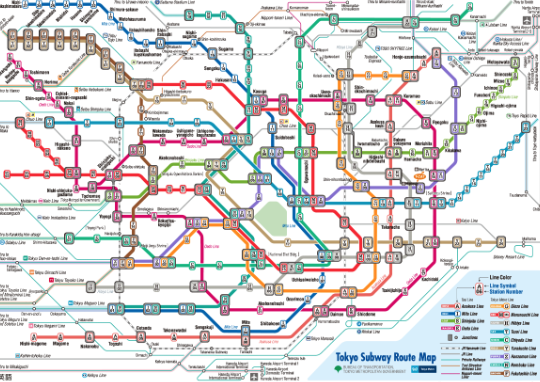“Today I’m pleased to present a new vision for our company! We are going to make our competition look like junior players when we roll out service capabilities they’ve only dreamed of! To do that, we will replace several of our major systems, overhaul our data, introduce cutting-edge AI capabilities, and streamline internal processes to enable speed and excellence at every level.
“Now this a tall order but we have a plan. It’s a little complex, but not to worry, your managers will break it down and walk you through it. It’s about time we crushed the competition. Are you excited?? Yeah!!”
Back in their units, employees get a first look at the plan. There is a LOT to be done. Multiple phases, crossing lines of integration and dependency. It looked something like…the Tokyo subway map.
Look at the above map. This is how employees often see “dis-organizational change.” A spaghetti diagram in a foreign language. When my daughter and I first faced this map in Tokyo, can you imagine how we felt?
- I can’t do it
- It’s too much for me
- Even if I wanted to, what if I fail and get us lost?? Better to stay at this nice bakery by the station.
Staring at the subway system wasn’t helping, so I adopted a few helpful tactics:
1. Buddy up
I admit there were a few times when I got us going in the wrong direction. Alexia spotted signs and landmarks that I missed. Two are better than one when navigating. We helped each other figure out menus and money.
When change requires training and practicing new behaviors assign a buddy to each person so they can help one another when a leader isn’t readily available to assist.
2. Zoom in
When the route demanded multiple trains, we focused on one at a time. Chiba station on route to Akihabara. Yes, we could manage that.
It seems counterintuitive to take your eyes off the goal, but people who are apprehensive need quick easy wins. Get them focused on mastering the first step before tackling the second.
3. Call Toll Free
A friend reinforced that we should ALWAYS ask for help when needed in Japan. The people are very friendly. In Hiroshima, we arrived at the train station just as all of the ticket machines shut down. We were a bit bewildered until we approached a few different people who explained that a suspicious package had shut down the train lines. While waiting, a kind man translated the announcements and let us know when we should prepare to board the train again.
Have you set a norm that confusion is normal? Have you clearly identified where to go for help when needed? When a buddy isn’t enough or when inevitable mistakes are made, everyone needs a safe path to assistance.
4. Distribute tools
Travel has changed dramatically. Google Maps and Google Translate make lives so much easier. We used them constantly to read signs and menus.
FAQs and project wikis are common: Indexed websites with answers to every question. Today we can go further with helpful apps, coaching guides for leaders, and chatbots for customers. What tools will make it easier for your people to navigate the journey? What information can be put in their hands so they can help themselves?
The psychology of change tells us that stress can create tunnel vision. We miss a simple turn and all of a sudden we feel lost. An unpredictable future has people hunkering down until it passes. But it won’t pass. Change is the new normal. Sometimes it looks like a Tokyo subway map. Help them pack for a successful journey.
Thoughtfully yours,
Jeff Skipper



